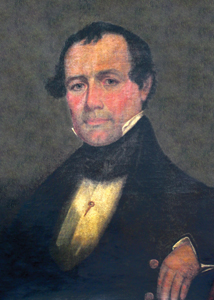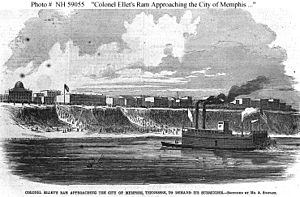John Miller Srodes facts for kids
Quick facts for kids
John Miller Srodes
|
|
|---|---|

Portrait of Srodes, 1842
|
|
| Born | July 17, 1809 Grant's Hill, Pittsburgh, Pennsylvania |
| Died | September 30, 1882 (aged 73) Phillipsburg, Pennsylvania |
| Allegiance | |
| Service/ |
Union Army |
| Commands held | USS Lioness |
| Battles/wars | Mexican–American War American Civil War |
| Other work | Riverboat Captain |
John Miller Srodes (July 17, 1809 – September 30, 1882) was a brave officer who served in the Union Army during the American Civil War. He was part of the Mississippi Marine Brigade. As a captain, he commanded the Lioness from April 28 to July 16, 1862. Captain Srodes played a very important part in the Battle of Memphis.
Early Life and Adventures
John Miller Srodes was born in Pittsburgh, Pennsylvania, on July 17, 1809. When he was a boy, a story says he ran away from home after an argument with his brothers. He was found and taken in by Native Americans. He lived with them for two or three years. He learned their language, customs, and way of life.
His time with the Native Americans likely shaped his views on people from different backgrounds. Later in life, when his granddaughter saw a Black person for the first time and was scared, Srodes encouraged her to talk to the man. He wanted her to be open-minded. His early adventures also prepared him for long journeys. Three times, he walked all the way from New Orleans to Pittsburgh! He would travel by flatboat to New Orleans, then walk home.
Military Service
Before the Civil War, John Srodes was a skilled ship captain. He guided boats along rivers from Pittsburgh to places like Cairo, Illinois, and Memphis, Tennessee. He also served as a captain in the Mexican–American War. During that war, he fought in several battles with General Zachary Taylor's army.
During the American Civil War, John Srodes became the captain of the Ram Lioness. This ship was part of the United States Ram Fleet. This special fleet was led by Colonel Charles Ellet, Jr.. The Ram Fleet had nine steam-powered ships. Their main job was to ram into enemy ships and sink them. They didn't have guns, just a strong, reinforced front.
The Battle of Memphis
Colonel Ellet led the Ram Fleet into the Battle of Memphis on June 6, 1862. The Union fleet quickly defeated the Confederate ships. After the battle, a white flag appeared over Memphis. This meant the city wanted to surrender. Colonel Ellet had been wounded, so he sent his son, Charles Rivers Ellet, to accept the surrender.
Captain Srodes took Charles Rivers Ellet ashore on the Lioness. The Lioness was the last ram to arrive because it was carrying coal for the fleet. Charles Rivers Ellet and three other Union soldiers went to meet the mayor of Memphis. The Confederate army had already left the city. So, the mayor couldn't officially surrender.
However, Charles Rivers Ellet insisted on raising the American flag over the post office. This would show that Memphis had fallen to the Union. The mayor warned them it might not be safe. But Ellet didn't listen. He convinced the mayor to take them to the post office.
When they raised the flag, people in the city started yelling and shooting at them. The mayor rushed back to the Lioness for help. Captain Srodes then went ashore. He bravely threatened to fire on the city if the Union soldiers were not released. Even though the Lioness had no guns, Srodes sent his marines ashore. They carried carbines and hand grenades to make it look like they were ready to fight.
Thousands of people gathered, shouting at the marines. But then, a warehouse exploded nearby. This distracted the crowd, and they scattered. Srodes quickly sent men to rescue the soldiers trapped on the post office roof. The Union flag, which was actually the Lioness's own flag, was left flying over the post office.
During his time in the military, Captain Srodes was injured. A shell hit his back, causing a spinal injury. This happened in May or June 1862 on the Yazoo River. He also became sick with malarial fever. Doctors on the Lioness treated him for his injuries and illness.
Family Life
On October 14, 1830, John Srodes married Eliza Quinn. They had seven children together. Sadly, Eliza passed away on Christmas Day in 1856. John was away on a riverboat trip and didn't learn about her death until he returned home.
He later married Nancy Galbraith Chase on December 17, 1857. In his older years, Srodes became an innkeeper in Phillipsburg, Pennsylvania. He passed away at his home on September 30, 1882.


